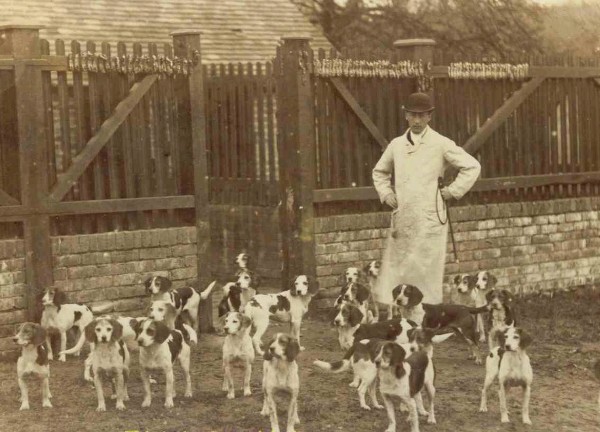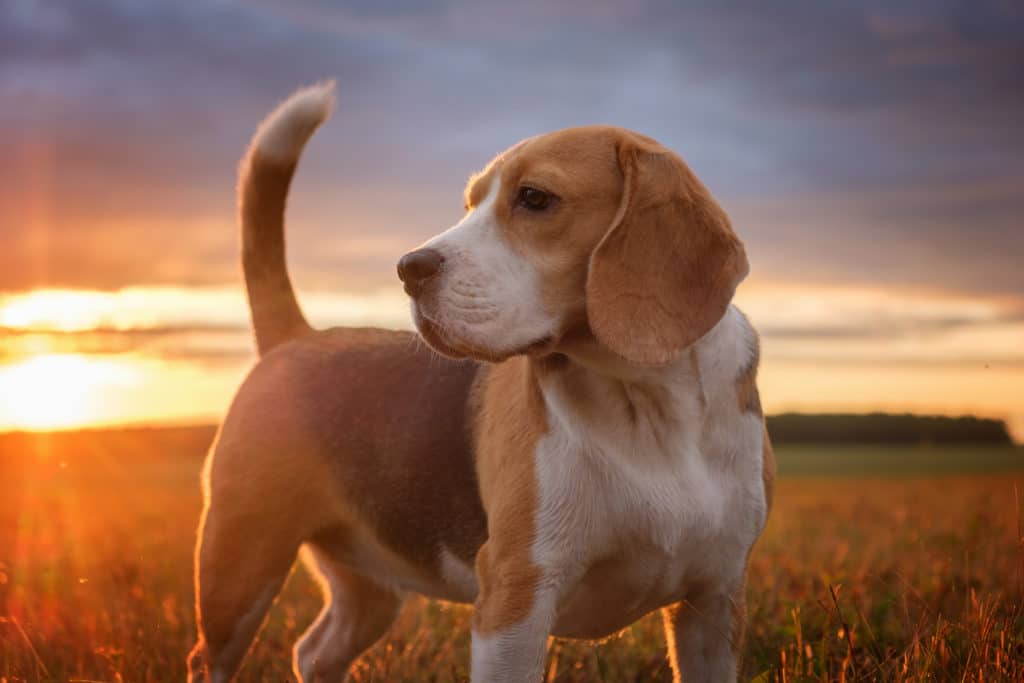The beagle is a breed of small hound that is similar in appearance to the much larger foxhound. The beagle is a scent hound, developed primarily for hunting hare (beagling). Possessing a great sense of smell and superior tracking instincts, the beagle is the primary breed used as detection dogs for prohibited agricultural imports and foodstuffs in quarantine around the world. The beagle is intelligent. It is a popular pet due to its size, good temper, and a lack of inherited health problems.
The modern breed was developed in Great Britain around the 1830s from several breeds, including the Talbot Hound, the North Country Beagle, the Southern Hound, and possibly the Harrier.
Beagles have been depicted in popular culture since Elizabethan times in literature and paintings, and more recently in film, television, and comic books.
Name
According to the Oxford English Dictionary, the first mention of the beagle by name in English literature dates from c. 1475 in The Squire of Low Degree. The origin of the word “beagle” is uncertain, although it has been suggested that the word derives from the French begueule.
It is not known why the black and tan Kerry Beagle, present in Ireland since Celtic times, has the beagle description, since at 22 to 24 inches (56 to 61 cm) it is significantly taller than the modern-day beagle, and in earlier times was even larger. Some writers suggest that the beagle’s scenting ability may have come from cross-breeding earlier strains with the Kerry Beagle. Originally used for hunting stags, it is today used for hare and drag hunting.
History

The origin of the beagle is not known. In the 11th century, William the Conqueror brought the St. Hubert Hound and the Talbot hound to Britain. In Britain, both of these strains were then crossed with Greyhounds to give them speed and stamina for deer hunting. Beagles are similar to the Harrier and the extinct Southern Hound, though smaller and slower.
From medieval times, beagle was used as a generic description for the smaller hounds, though these dogs differed considerably from the modern breed. Miniature breeds of beagle-type dogs were known from the times of Edward II and Henry VII, who both had packs of Glove Beagles, so named since they were small enough to fit on a glove, and Queen Elizabeth I kept a breed known as a Pocket Beagle, which stood 8 to 9 inches (20 to 23 cm) at the shoulder. Small enough to fit in a “pocket” or saddlebag, they rode along on the hunt. The larger hounds would run the prey to ground, then the hunters would release the small dogs to continue the chase through underbrush. Elizabeth I referred to the dogs as her singing beagles and often entertained guests at her royal table by letting her Pocket Beagles cavort amid their plates and cups. 19th-century sources refer to these breeds interchangeably and it is possible that the two names refer to the same small variety. In George Jesse’s Researches into the History of the British Dog from 1866, the early 17th-century poet and writer Gervase Markham are quoted referring to the beagle as small enough to sit on a man’s hand and to the:
little small mitten-beagle, which may be a companion for a ladies kirtle, and in the field will run as cunningly as any hound whatere, only their musick is very small like reeds.
Standards for the Pocket Beagle were drawn up as late as 1901; these genetic lines are now extinct, although modern breeders have attempted to recreate the variety. By the 18th century, two breeds had been developed for hunting hare and rabbit: the Southern Hound and the North Country Beagle (or Northern Hound). The Southern Hound, a tall, heavy dog with a square head, and long, soft ears, was common from south of the River Trent and probably closely related to the Talbot Hound. Though slow, it had stamina and excellent scenting ability. The North Country Beagle, possibly a cross between an offshoot of the Talbot stock and a Greyhound, was bred chiefly in Yorkshire and was common in the northern counties. It was smaller than the Southern Hound, less heavy-set and with a more pointed muzzle. It was faster than its southern counterpart but its scenting abilities were less well developed.
Hunting
Beagles were developed primarily for hunting hare, an activity known as beagling. They were seen as ideal hunting companions for the elderly who could follow on horseback without exerting themselves, for young hunters who could keep up with them on ponies, and for the poorer hunters who could not afford to maintain a stable of good hunting horses. Before the advent of the fashion for foxhunting in the 19th century, hunting was an all-day event where the enjoyment was derived from the chase rather than the kill. In this setting, the tiny beagle was well matched to the hare, as unlike Harriers they would not quickly finish the hunt, but because of their excellent scent-tracking skills and stamina, they were almost guaranteed to eventually catch the hare. The beagle packs would run closely together (“so close that they might be covered with a sheet”) which was useful in a long hunt, as it prevented stray dogs from obscuring the trail. In thick undergrowth, they were also preferred to spaniels when hunting pheasant.
With the fashion for faster hunts, the beagle fell out of favour for chasing a hare but was still employed for rabbit hunting. In Anecdotes of Dogs (1846), Edward Jesse says:
In rabbit-shooting, in gorse and thick cover, nothing can be more cheerful than the beagle. They also are easily heard over long distances and in thick cover. They have been called rabbit-beagles from this employment, for which they are peculiarly qualified, especially those dogs which are somewhat wire-haired.
In the United States, they appear to have been employed chiefly for hunting rabbits from the earliest imports. Hunting hare with beagles became popular again in Britain in the mid-19th century and continued until it was made illegal in Scotland by the Protection of Wild Mammals (Scotland) Act 2002 and in England and Wales by the Hunting Act 2004. Under this legislation, beagles may still pursue rabbits with the landowner’s permission. Drag hunting is popular where hunting is no longer permitted or for those owners who do not wish to participate in hunting a live animal but still wish to exercise their dog’s innate skills.
The traditional foot pack consists of up to 40 beagles, marshalled by a Huntsman who directs the pack and who is assisted by a variable number of whippers-in whose job is to return straying hounds to the pack. The Master of the Hunt is in overall day-to-day charge of the pack, and may or may not take on the role of Huntsman on the day of the hunt.
As hunting with beagles was seen as ideal for young people, many of the British public schools traditionally maintained beagle packs. Protests were lodged against Eton’s use of beagles for hunting as early as 1902 but the pack is still in existence today, and a pack used by Imperial College in Wye, Kent was stolen by the Animal Liberation Front in 2001. School and university packs are still maintained by Eton, Marlborough, Wye, Radley, the Royal Agricultural University and Christ Church, Oxford.
In addition to organized beagling, beagles have been used for hunting or flushing to guns (often in pairs) a wide range of game including snowshoe hare, cottontail rabbits, game birds, roe deer, red deer, bobcat, coyote, wild boar and foxes, and have even been recorded as being used to hunt stoat. In most of these cases, the beagle is employed as a gun dog, flushing game for hunter’s guns.
